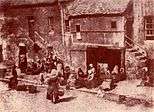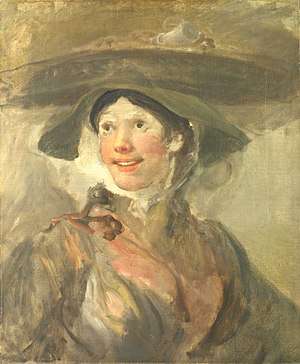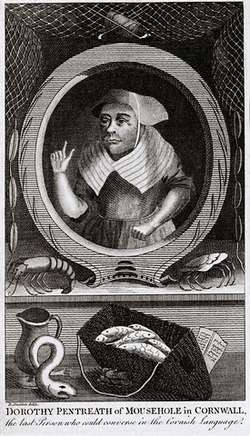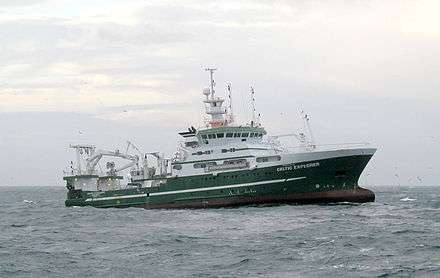Fishwife
A fishwife, fish-fag[1] or fishlass is a woman who sells fish.[2]

Often the wives and daughters of fishermen, fishwives were notoriously loud and foul-mouthed, as noted in the expression, To swear like a fishwife. One reason for their outspokenness is that their wares were highly perishable and so lost value if not sold quickly.[3] Fishwives in fishing villages such as Cullercoats and Newhaven were noted for their beauty, hardiness and industry and were celebrated by artists and royalty.
In this context, the word wife means woman rather than married woman.[4] This usage stems from Old English wif (woman) and is cognate with the German Weib and the Dutch Wijf, also meaning "woman" (nowadays rarely used and usually in a pejorative sense).
Billingsgate
.png)
London's traditional fish market was frequented by such types who were known as "the wives of Billingsgate". "They dressed in strong 'stuff' gowns and quilted petticoats; their hair, caps and bonnets were flattened into one indistinguishable mass upon their heads. ... They smoked small pipes of tobacco, took snuff, drank gin and were known for their colourful language."[5]
In the 18th century, fishwives frequently appeared in satires as fearsome scourges of fops and foreigners. Their vigorous and decisive mien was contrasted with that of politicians who were, by contrast, portrayed as vacillating and weak. For example, in Isaac Cruikshank's A New Catamaran Expedition!!!, a fleet of Billingsgate fishwives sails across the English Channel to terrorise the French and shame the British Prime Minister Pitt for his inaction.[6]
Cullercoats
William Finden noted, in 1842, that the wives and daughters of the Cullercoats fishermen searched for the bait, digging sand-worms, gathering mussels or seeking limpets and dog-crabs. They also assisted in baiting the hooks. In addition to this, they carried the fish to the market to sell them. "When fish are scarce, they not unfrequently carried a load on their shoulders, weighing between 3 or 4 stone (42 or 56 lb; 19 or 25 kg), to Newcastle, which is about ten miles distant from Cullercoats, in the hope of meeting with a better market."[7]
Edward Corvan wrote and performed a popular music hall song about the Cullercoats Fish Lass in 1862:[8]
- Aw's a Cullercoats fish-lass, se cozy an' free
- Browt up in a cottage close on by the sea;
- An' aw sell fine fresh fish ti poor an' ti rich--
- Will ye buy, will ye buy, will ye buy maw fresh fish?
The Cullercoats Fishlass became a popular subject of American artist, Winslow Homer, who resided in the picturesque fishing village, to paint, from the spring of 1881 to November 1882. Homer soon became sensitive to the strenuous and courageous lives of its inhabitants, particularly the women, whom he depicted hauling and cleaning fish, mending nets, and, most poignantly, standing at the water's edge, awaiting the return of their men.
Jean F. Terry wrote, in 1913, "The Cullercoats fishwife, with her cheerful weather-bronzed face, her short jacket and ample skirts of blue flannel, and her heavily laden "creel" of fish is not only appreciated by the brotherhood of brush and pencil, but is one of the notable sights of the district".[9]
William S. Garson, in his 1935 book, The Romance of Old Tynemouth and Cullercoats, wrote: "The Cullercoats fishwife plays a man's part in helping to launch the lifeboat, frequently wading waist-high into furious and ice-cold waters, and she never hesitates to allow her man to take a place on the boat, though he may go to face death and disaster."[10]
Newhaven
The Scottish fishwives of Newhaven had a reputation for their beauty and industry and so were celebrated by royalty — George IV and Queen Victoria. They were hard-bargainers though, and all the fishermen of the Firth of Forth brought their catches to Newhaven for the fishwives to sell in Edinburgh. The fishwives wore distinctive costumes of blue duffle coats covering layers of colourful striped petticoats with a muslin cap or other similar headdress. Their fish, such as haddock and herring, were carried on their backs in creels.[11]
Gallery
 Fishwives in St Andrews, Scotland bait their lines
Fishwives in St Andrews, Scotland bait their lines Statue of the Nairn Fishwife
Statue of the Nairn Fishwife The fishwife, Holland 1672 by Adriaen van Ostade
The fishwife, Holland 1672 by Adriaen van Ostade Notorious Victorian fishwife Dolly Peel, of South Shields
Notorious Victorian fishwife Dolly Peel, of South Shields Newhaven fishwife with creel (by Alexander Ignatius Roche 1861–1921)
Newhaven fishwife with creel (by Alexander Ignatius Roche 1861–1921) Bronze cast statue of a fishwife and little girl, Peterhead
Bronze cast statue of a fishwife and little girl, Peterhead The Shrimp Girl by William Hogarth, c. 1740-1745
The Shrimp Girl by William Hogarth, c. 1740-1745 Fisherwomen, Cullercoats, Winslow Homer 1881
Fisherwomen, Cullercoats, Winslow Homer 1881 Dolly Pentreath (a Cornish fish jowster), in an engraved portrait published in 1781
Dolly Pentreath (a Cornish fish jowster), in an engraved portrait published in 1781
Famous fishwives
- Dolly Peel – a fishwife of South Shields
- Dolly Pentreath – the last native speaker of Cornish
- Marretje Arents – Dutch fishwife and rebel
- Molly Malone – the subject of an Irish song
- Annie Sandercock – the artist, dancer and celebrated wrestler.
See also
References
- E. Cobham Brewer (1898), "Billingsgate", Dictionary of Phrase and Fable
- Oxford English Dictionary. Retrieved 2008-04-27.
A woman who sells fish
- Gary Taylor (1981). "Touchstone's Butterwomen". The Review of English Studies. Oxford University Press. XXXII (126): 187–193. doi:10.1093/res/XXXII.126.187.
- "Online Etymology Dictionary". Retrieved 2010-11-10.
- Peter Ackroyd (2003). London: The Biography. Anchor. ISBN 0-385-49771-7.
- McCreery, Cindy (2004). The Satirical Gaze: Prints of Women in late Eighteenth-century England. Oxford: Clarendon Press. ISBN 978-0-19-926756-9.
- The Ports, Harbours, Watering-places and Picturesque Scenery of Great Britain; Vol. 1, William Finden, 1842
- "The Cullercoats Fish Lass" Edward Corvan, 1862, in Allan's Illustrated Edition of Tyneside Songs and Readings 1891
- "Northumberland Yesterday and Today" 'Jean F Terry' 1913
- Garson, William (1935). The Romance of Old Tynemouth and Cullercoats.
- James Glass Bertram (1866). "The harvest of the sea". Appleton: 424 et seq. Cite journal requires
|journal=(help) - India - Fish seller (Photograph). Kochi: Jorge Royan. 27 February 2007. uuid 10C00CB64F8311DF970A8E6787EBB675.
- https://web.archive.org/web/20190801222331/https://www.brettcolephotography.com/-/galleries/india/kolkata-calcutta/page/11
| Wikimedia Commons has media related to Fishwives. |
